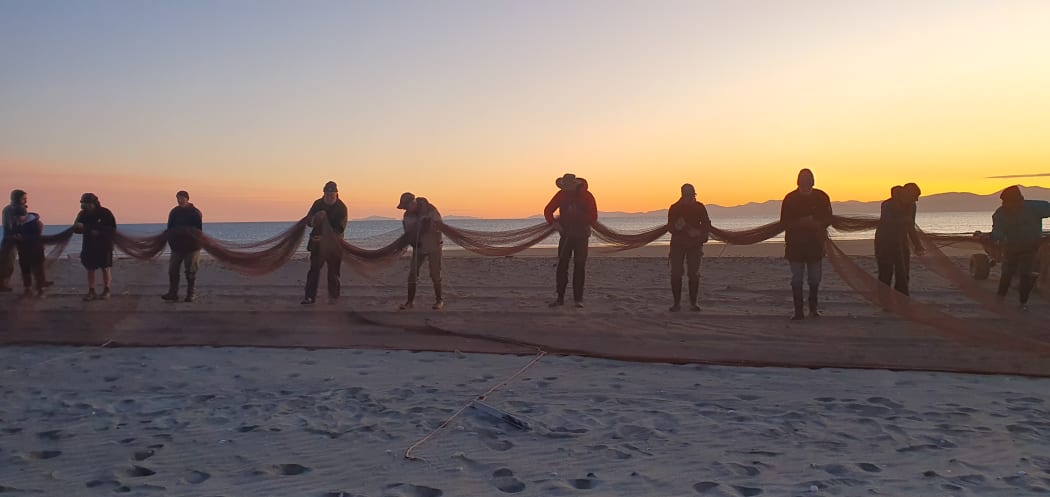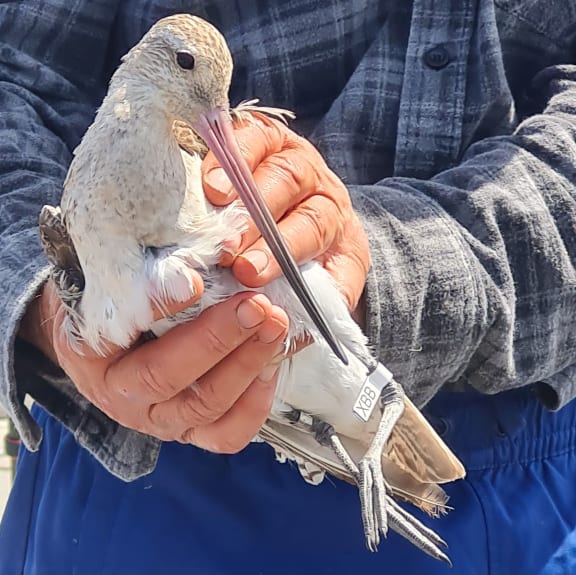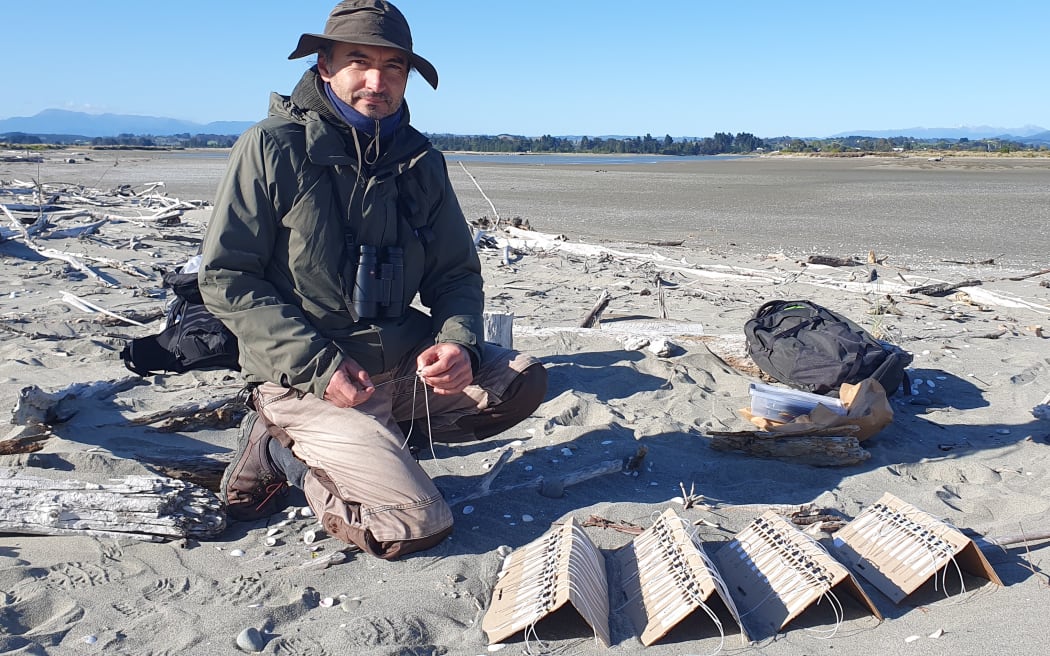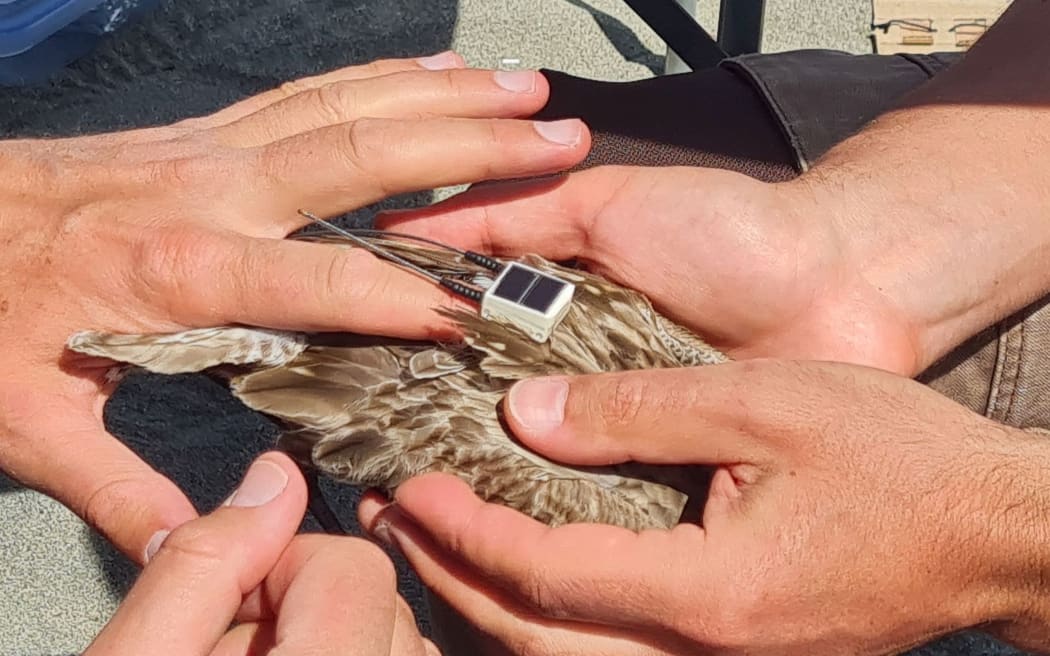
Bar-tailed godwit in breeding colour ready to fly from its summer feeding grounds in New Zealand to its breeding grounds in Alaska. Photo: Rebecca Bowater
Follow Our Changing World on Apple Podcasts, Spotify, iHeartRADIO or wherever you listen to your podcasts
Godwits hold the record for non-stop long-distance flight – and scientists are wondering when they find time to sleep on the wing.
The long-distance godwit migration
Eastern bar-tailed godwits or kuaka spend up to six months every year in Australasia. At last count, in 2020, the total summer population was estimated at 126,000 birds – 78,000 birds were in New Zealand and the rest in eastern Australia.
After spending the summer feeding on rich intertidal mudflats in the southern hemisphere, the godwits fly north in March. They follow a route known as the East Asian-Australasian Flyway, which takes them to Alaska, via the Yellow Sea. From New Zealand they take seven or eight days to cover the 10,000-or-so kilometres to reach large areas of tidal mudflats in China, Taiwan and Korea. They feed here for four to six weeks, before moving on to the Alaskan tundra, where they breed.
In October they return south, and it is these journeys that have catapulted the godwits into the record books.

A flock of bar tailed godwits wheels over the Motueka sandspit Photo: Alison Ballance
Long-haul champions
Godwits make the longest non-stop migration of any bird. We only discovered this when satellite trackers got small enough to be used on them.
In 2007, a female known as E7, set the first record: 11,680 kilometres non-stop. With no breaks for food or rest, she flew for more than eight days, over the open Pacific Ocean, from Alaska to New Zealand.
E7’s epic migration has since been eclipsed by the 13,560 kilometre non-stop journey made by bird B6 in 2022. B6 was tagged as a juvenile in Alaska and was just 5 months old when it made its first-ever 11-day flight to Tasmania. Scientists do not know how these young birds find their way to New Zealand and Australia on that first flight – they fly in flocks, and perhaps these flocks include an adult guide?

Sorting the cannon net at dawn on the Motueka sandspit. Photo: Alison Ballance
Sleep in birds
If you’ve ever taken a long-haul flight from New Zealand you’ve probably experienced sleep deprivation. Now imagine you’re a small bird, flapping your wings continuously, unable to land or feed, on a flight that will take anywhere from 8 to 11 days. When and how do you sleep?

Bar tailed godwit marked with a leg flag Photo: Michelle Bradshaw
How godwits sleep during their epic flights is the focus of a new research project involving 45 godwits from the Motueka sandspit.
This sleep project involves ornithologist Jesse Conklin, from the United States, and Bart Kempenaers, Mihai Valcu and avian sleep expert Niels Rattenborg, all from the Max Planck Institute for Biological Intelligence, in Germany.
Sleep is a basic requirement for all creatures – even jellyfish sleep. In birds, most sleep is slow wave or deep sleep. Sometimes just one side of a bird’s brain sleeps, sometimes both hemispheres are asleep. Sleep in humans, on the other hand, always involves the whole brain.
We also experience lengthy bouts of REM or rapid eye movement sleep, when our bodies go floppy – in birds, REM sleep is a fleeting second or three and they don’t lose the ability to move. Wading birds, for example, often stand on one leg while resting and it wouldn’t be a good idea to collapse to the ground when you fell into a REM sleep!
Penguins are masters of the microsleep
One of Neils’ earlier projects involved studying chinstrap penguins, while they were at the nest incubating eggs. The penguins were fitted with very hi-tech tags which used EEG to measure brain waves directly.
It turns out that the penguins are masters of the power nap. Each day they had thousands of microsleeps, each lasting just one to five seconds. Usually just one side of the brain took a micronap, so the other side could stay alert for danger. You even could see this in action – one eye would briefly flicker shut, then it would open and the other eye might close for a few seconds. Over the course of 24 hours, these tiny sleeps accumulated to nearly 12 hours of sleep.
Snoozing while soaring
Neils’ team used the same EEG tags on frigatebirds. Tropical frigatebirds have long wings and are experts at locking their wings so they can glide effortlessly. They spend many days or even weeks at a time out at sea hunting for food, and – like the godwit – cannot land on water to rest.
It turns out that frigatebirds grab shuteye around sunset when they are high up circling on thermals of rising warm air. They lock their wings, and one side of their brain goes to sleep for up to six minutes at a time, while the other side stays alert to make sure they don’t crash into another snoozing frigatebird. Forty minutes to an hour a day is enough to keep them going while they are at sea, and when they are back at the nest they catch up on lost sleep.

Mihai Valcu checks on the solar 5G tags which are charging in the sun. Photo: Alison Ballance
The godwit sleep study smart tags
Bart and colleagues want to measure sleep deprivation in godwits, which, unlike soaring frigatebirds, must flap their wings continuously to stay aloft.
In spring 2023, 45 godwits at the Motueka estuary were fitted with smart solar-powered tags that weigh just 4.5 grams. The tags measure parameters such as time, altitude and acceleration, and send their data back via 5G mobile networks.
Are godwits the ultimate power-nappers?
The team’s hypothesis is that godwits might be able to snatch microsleeps by putting themselves in a glide for a few seconds, and gradually accumulate enough sleep that way. The data collected by the tag should show if these glides are happening.
Once the sleep-deprived godwits arrive in New Zealand, the tags will measure a bird’s activity and indicate whether it has engaged in prolonged sleep catch-up.
Listen to the full episode to hear more about godwits and sleep, as well as revelations from earlier research on New Zealand godwits, such as the factors controlling the timing of their migrations and how juveniles fly all around the country before settling down at their preferred summering site.

A godwit being fitted with a solar powered smart tag which is fitted with a stretchy backpack harness. Photo: Michelle Bradshaw
Learn more:
-
Find out more about the science of sleep in humans in Sleeping on the job.
-
Alison Ballance has also been in search of Shorebirds at Miranda and she first met Jesse Conklin when he was studying godwits at Foxton Estuary for his PhD.


